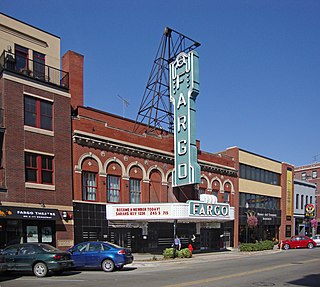
Fargo is a city in and the county seat of Cass County, North Dakota, United States. According to the 2020 census, its population was 125,990, making it the most populous city in the state and the 216th most populous city in the United States. Fargo, along with its twin city of Moorhead, Minnesota, and the adjacent cities of West Fargo, North Dakota and Dilworth, Minnesota, form the core of the Fargo–Moorhead, ND-MN Metropolitan Statistical Area (MSA). The MSA had a population of 248,591 in 2020.
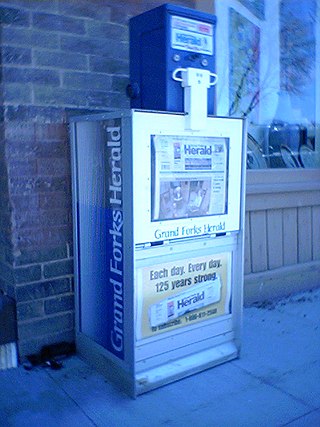
The Grand Forks Herald is a daily broadsheet newspaper, established in 1879, published in Grand Forks, North Dakota, United States. It is the primary daily paper for northeast North Dakota and northwest Minnesota. Its average daily circulation is approximately 7,500, in the city of Grand Forks plus about 7,500 more to the surrounding communities. Total circulation includes digital subscribers. It has the second largest circulation in the state of North Dakota.

The Forum of Fargo-Moorhead or more recently The Forum is an American, English language newspaper. It is the major newspaper for Fargo, North Dakota and the surrounding region, including Moorhead, Minnesota. It is the flagship and namesake of Forum Communications. The Forum, as it is commonly known, is the primary paper for southeast North Dakota, and also much of northwest Minnesota. Its average daily circulation was about 47,100 on Sundays and 37,500 on Saturdays prior to reducing its print schedule to semi-weekly. The Fargo Forum was first published on November 17, 1891 by Major A. W. Edwards. However, it traces its lineage to The Republican, which had been founded by Edwards in 1878 and merged into the Forum in 1894.

KVRR is a television station in Fargo, North Dakota, United States, affiliated with the Fox network. Owned by Coastal Television Broadcasting Company, the station maintains studios on South 40th Street and South 9th Avenue in Fargo, and its transmitter is located near Tansem, Minnesota. KVRR also handles master control and some internal operations for sister station and fellow Fox affiliate KQDS-TV in Duluth, Minnesota.

WDAY-TV is a television station in Fargo, North Dakota, United States, affiliated with ABC. It serves as the flagship television property of locally based Forum Communications Company, which also owns WDAY radio and The Forum of Fargo-Moorhead. The television and radio stations share studios on South 8th Street in downtown Fargo, while WDAY-TV's transmitter is located near Amenia.

WDAY is North Dakota's oldest radio station, having first signed on in 1922. WDAY is licensed to Fargo, North Dakota, owned by Forum Communications, and operated by Flag Family Media. The transmitter site is near 210th Street South in Barnesville, Minnesota, and studios are on 8th Street South in Fargo.

The Minneapolis Armory is a historic event center and former National Guard armory located in downtown Minneapolis, Minnesota, United States. Built by the Public Works Administration in 1936, the building was occupied by several Army and Naval Militia units of the Minnesota National Guard from its opening until 1985. The building is listed on the National Register of Historic Places.

Fargo Station is a train station in Fargo, North Dakota, United States. It is served by Amtrak's Empire Builder. It is the only railway station in use in the Fargo-Moorhead area and is the third-busiest in North Dakota. The platform, tracks, and station are currently all owned by BNSF Railway. The station is currently located in the former BNSF freight house. The former main station building is now home to Great Northern Bicycle Co.

Frederick Gardner Corser was an American architect of homes and public buildings in the U.S. states of Minnesota, North Dakota, and South Dakota, especially in the Minneapolis, Minnesota area.
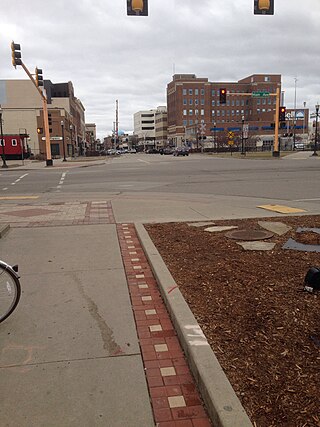
Downtown Fargo District, or Downtown Fargo Historic District, is a historic district in Fargo, North Dakota that was listed on the National Register of Historic Places in 1983.

The Fargo station is a former railway station in Fargo, North Dakota. Built in 1898, it was listed on the National Register of Historic Places in 1975 as the Northern Pacific Railway Depot.
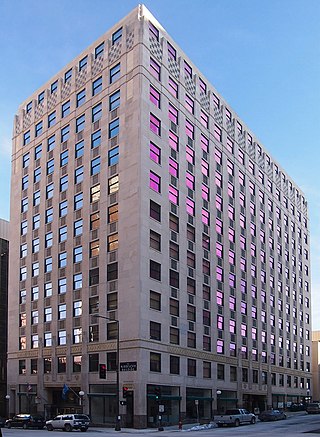
The Minnesota Building is a historic office building in Saint Paul, Minnesota, United States. The structure was placed on the National Register of Historic Places (NRHP) on June 10, 2009. The building was noted for its design, which was a harbinger for the transition from Classical architecture to the Art Deco/Moderne among commercial buildings in downtown Saint Paul; originally designed in a conservative style, the building became more Moderne as it was being built.

North Dakota State University District is a 36-acre (15 ha) historic district on the campus of North Dakota State University, in Fargo, North Dakota, that was listed on the National Register of Historic Places in 1986.
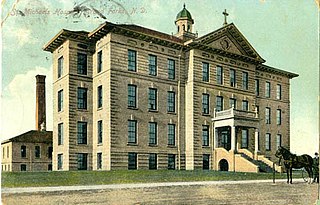
George Hancock was an architect active in North Dakota, Montana and Minnesota.

Haxby & Gillespie was an architectural firm from Fargo, North Dakota. R. J. Haxby and William D. Gillespie were the partners. The firm "produced a number of important buildings throughout North Dakota." They designed many notable public, educational, commercial, and church buildings, in North Dakota, Minnesota, and Montana.

William F. Kurke (1889–1965) was a prolific architect in North Dakota.

The Fargo Oak Grove Residential Historic District is a historic district located around North and South Terrace Avenues near downtown Fargo, North Dakota. The homes date from the period 1895 to 1952 and include working-class, gable-fronted cottages and vernacular bungalows." The district was listed on the National Register of Historic Places in 2011.
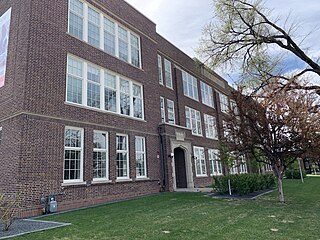
The Woodrow Wilson School in Fargo, North Dakota is a historic building that is listed on the National Register of Historic Places. It was added to the Registry on October 24, 2012, as entry #12000881. It was deemed notable for its Collegiate Gothic design by local architects Haxby and Braseth. The school "is also a good example of how design changed to meet Progressive-era education ideas."
The following is a timeline of the history of the city of Fargo, North Dakota, USA.
Liebenberg and Kaplan (L&K) was a Minneapolis architectural firm founded in 1923 by Jacob J. Liebenberg and Seeman I. Kaplan. Over a fifty-year period, L&K became one of the Twin Cities' most successful architectural firms, best known for designing/redesigning movie theaters. The firm also designed hospitals, places of worship, commercial and institutional buildings, country clubs, prestigious homes, radio and television stations, hotels, and apartment buildings. After designing Temple Israel and the Granada Theater in Minneapolis, the firm began specializing in acoustics and theater design and went on to plan the construction and/or renovation of more than 200 movie houses throughout Minnesota, North and South Dakota, Iowa, and Wisconsin. Architectural records, original drawings, and plans for some 2,500 Liebenberg and Kaplan projects are available for public use at the Northwest Architectural Archives.





















